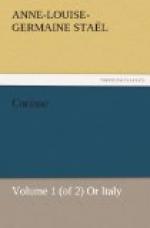That thought which has nothing to nourish it from without, turns upon itself, analyses, labours, and dives into every inward sentiment; but it has no longer that creative power which supposes happiness, and that plenitude of strength which happiness alone can give. Even the sarcophagi, among the ancients, only recall warlike or pleasing ideas: in the multitude of those which are to be found at the museum of the Vatican, are seen battles and games represented in bas-relief on the tombs. The remembrance of living activity was thought to be the finest homage that could be rendered to the dead; nothing relaxed, nothing diminished strength. Encouragement and emulation were the principles of the fine arts as well as of politics; they afforded scope for every virtue, and for every talent. The vulgar gloried in knowing how to admire, and the worship of genius was served even by those who could not aspire to its rewards.
The religion of Greece was not, like Christianity, the consolation of misfortune, the riches of poverty, the future hope of the dying—it sought glory and triumph;—in a manner it deified man: in this perishable religion, beauty itself was a religious dogma. If the artists were called to paint the base and ferocious passions, they rescued the human form from shame, by joining to it, as in Fauns and Centaurs, some traits of the animal figure; and in order to give to beauty its most sublime character, they alternately blended in their statues (as in the warlike Minerva and in the Apollo Musagetus), the charms of both sexes—strength and softness, softness and strength; a happy mixture of two opposite qualities, without which neither of the two would be perfect.
Corinne, continuing her observations, retained Oswald some time before those sleeping statues which are placed on the tombs, and which display the art of sculpture in the most agreeable point of view. She pointed out to him, that whenever statues are supposed to represent an action, the arrested movement produces a sort of astonishment which is sometimes painful. But statues asleep, or merely in the attitude of complete repose, offer an image of eternal tranquillity which wonderfully accords with the general effect of a southern climate upon man. The fine arts appear there to be peaceful spectators of nature, and genius, which in the north agitates the soul of man, seems beneath a beautiful sky, only an added harmony.




